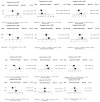Comparative Analysis of Open, Laparoscopic, and Robotic Pancreaticoduodenectomy: A Systematic Review of Randomized Controlled Trials
- PMID: 40731751
- PMCID: PMC12298437
- DOI: 10.3390/medicina61071121
Comparative Analysis of Open, Laparoscopic, and Robotic Pancreaticoduodenectomy: A Systematic Review of Randomized Controlled Trials
Abstract
Background and Objectives: Various publications have compared outcomes among open (OPDs), laparoscopic (LPDs), and robotic pancreaticoduodenectomies (RPDs); however, the number of randomized controlled trials (RCTs) remains limited. This study aims to conduct a systematic review and analyze the outcomes between these approaches from randomized controlled trials. Materials and Methods: We performed a systematic literature search across PubMed/MedLine, Cochrane Library, ClinicalTrials.gov, and Google Scholar to identify relevant RCTs. The systematic review was conducted using the reporting items for systematic reviews and network meta-analyses guidelines (PRISMA-NMA) and registered in Prospero (CRD420251024475). For statistical analysis R software (version 4.3.2) was used. Results: Eight RCTs involving 1416 patients (706 OPDs, 600 LPDs, 110 RPDs) were included. LPD had a significantly longer operative time than OPD, while RPD showed no significant difference compared to OPD. Blood loss was reduced in both minimally invasive approaches. LPD showed a higher R0 resection rate and lower pancreatic fistula rate, whereas RPD had the lowest mortality. No significant differences were observed in major complications, reoperation, or readmission. LPD shortened hospital stay; RPD showed no difference. Conclusions: Although open pancreaticoduodenectomy remains a well-established standard, both laparoscopic and robotic approaches offer safe alternatives with distinct advantages. LPD is associated with shorter hospital stay and lower pancreatic fistula rates, whereas RPD demonstrates the lowest mortality. The lack of direct randomized comparisons between LPD and RPD highlights the need for further head-to-head trials.
Keywords: laparoscopic pancreaticoduodenectomy; open pancreaticoduodenectomy; pancreatic cancer; pancreaticoduodenectomy; randomized controlled trials; robotic pancreaticoduodenectomy; systematic review.
Conflict of interest statement
The authors declare no conflicts of interest.
Figures




References
-
- Winter J.M., Cameron J.L., Campbell K.A., Arnold M.A., Chang D.C., Coleman J., Hodgin M.B., Sauter P.K., Hruban R.H., Riall T.S., et al. 1423 pancreaticoduodenectomies for pancreatic cancer: A single-institution experience. J. Gastrointest. Surg. 2006;10:1199–1210; discussion 1210–1211. doi: 10.1016/j.gassur.2006.08.018. - DOI - PubMed
-
- Tempero M.A., Malafa M.P., Al-Hawary M., Behrman S.W., Benson A.B., Cardin D.B., Chiorean E.G., Chung V., Czito B., Del Chiaro M., et al. Pancreatic Adenocarcinoma, Version 2.2021, NCCN Clinical Practice Guidelines in Oncology. J. Natl. Compr. Cancer Netw. 2021;19:439–457. doi: 10.6004/jnccn.2021.0017. - DOI - PubMed
Publication types
MeSH terms
LinkOut - more resources
Full Text Sources

